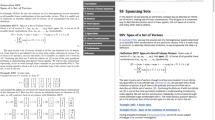Abstract
Authors of traditional mathematical texts often have difficulty balancing the amount of contextual information and proof detail. We propose a simple hypermedia framework that can assist in the organisation and presentation of mathematical theorems and definitions. We describe the application of the framework to convert an existing course in general topology to a web-based set of materials. Two user evaluations of the materials indicated both successful and unsuccessful aspects of the framework. We discuss further lines of investigation, in particular, the presentation of larger bodies of work.
Similar content being viewed by others
References
A. Asperti, L. Padovani, C. Sacerdoti Coen, F. Guidi and I. Schena, Mathematical knowledge management in HELM, in: First International Workshop on Mathematical Knowledge Management (2001).
T. Bray, J. Paoli, C.M. Sperberg-McQueen and E. Maler (eds.), Extensible Markup Language (XML) 1.0, 2nd edn., W3C Recommendation (October 2000), http://www.w3.org/TR/REC-xml.
J. Brooke, SUS – a quick and dirty usability scale, http://www.usability.serco.com/trump/methods/satisfaction.htm.
J. Clark (ed.), XSL Transformations 1.0, W3C Recommendation (November 1999), http://www.w3.org/TR/xslt.
D. Flanagan, JavaScript: The Definitive Guide, 3rd edn. (O'Reilly, 1998).
M. Goossens and S. Rahtz, The LAT EXWeb Companion (Addison-Wesley, Reading, MA, 1999).
J. Grundy, A browsable format for proof presentation, Math. Universalis 2 (1996), http://www.ant.pl/MathUniversalis/2/grundy/mu.html.
D. Knuth, Surreal Numbers (Addison-Wesley, Reading, MA, 1974).
M. Kohlhase, OMDOC: An Open Markup Format for Mathematical Documents, SEKI Report SRSR–00–02, Universität Des Saarlandes (2000).
I. Lakatos, Proofs and Refutations: The Logic of Mathematical Discovery (Cambridge University Press, 1976).
L. Lamport, How to write a proof, American Mathematical Monthly 102(7) (1994) 600–608.
L. Lamport, How LATEX changed the face of Mathematics: an E-interview with Leslie Lamport, www.cs.toronto.edu/pub/fanis/lamport-latex-interview.ps.
Mathematical Reviews, American Mathematical Society, www.ams.org/mr-database.
J. Nielsen, Usability Engineering (Academic Press, New York, 1993).
L.C. Paulson and K. Grabczewski, Mechanizing set theory, Journal of Automated Reasoning 17 (1996) 291–323.
G. Pólya, How to Solve It (Penguin Books, 1990).
G. Pólya, Mathematics and Plausible Reasoning (Princeton University Press, Princeton, NJ, 1968).
P. Ramsden, Learning to Teach in Higher Education (Routledge, 1992).
M.E. Rudin, Nikiel's conjecture, Topology and its Applications 116 (2001) 305–331.
B. Russell, The study of mathematics, in: Mysticism and Logic (Penguin, 1953).
S. Singh, Fermat's Last Theorem (Fourth Estate, 1998).
W.A. Sutherland, Introduction to Metric and Topological Spaces (Oxford University Press, 1985).
Y.L. Theng and H. Thimbleby, Addressing design and usability issues in hypertext and on the World Wide Web by re-examining the ‘lost in hyperspace’ problem, Journal of Universal Computer Science 4(11) (1998) 839–855.
Author information
Authors and Affiliations
Rights and permissions
About this article
Cite this article
Cairns, P., Gow, J. & Collins, P. On Dynamically Presenting a Topology Course. Annals of Mathematics and Artificial Intelligence 38, 91–104 (2003). https://doi.org/10.1023/A:1022963714083
Issue Date:
DOI: https://doi.org/10.1023/A:1022963714083




